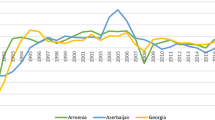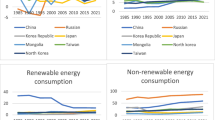Abstract
This article aims to investigate the relationship among renewable energy consumption, carbon dioxide (CO2) emissions, and GDP using panel data for 24 Asian countries between 1990 and 2012. Panel cross-sectional dependence tests and unit root test, which considers cross-sectional dependence across countries, are used to ensure that the empirical results are correct. Using the panel cointegration model, the vector error correction model, and the Granger causality test, this paper finds that a long-run equilibrium exists among renewable energy consumption, carbon emission, and GDP. CO2 emissions have a positive effect on renewable energy consumption in the Philippines, Pakistan, China, Iraq, Yemen, and Saudi Arabia. A 1% increase in GDP will increase renewable energy by 0.64%. Renewable energy is significantly determined by GDP in India, Sri Lanka, the Philippines, Thailand, Turkey, Malaysia, Jordan, United Arab Emirates, Saudi Arabia, and Mongolia. A unidirectional causality runs from GDP to CO2 emissions, and two bidirectional causal relationships were found between CO2 emissions and renewable energy consumption and between renewable energy consumption and GDP. The findings can assist governments in curbing pollution from air pollutants, execute energy conservation policy, and reduce unnecessary wastage of energy.
Similar content being viewed by others
Notes
The Kaya identity is as follows: \( {\mathrm{CO}}_2=\mathrm{Population}\times \frac{\mathrm{GDP}}{\mathrm{Population}}\times \frac{\mathrm{GDP}}{\mathrm{Population}}\times \frac{\mathrm{GDP}}{\mathrm{Population}} \).
The four hypotheses in the literature are growth, conservation, feedback, and neutrality hypotheses.
The website is http://www.epd.gov.hk/epd/english/top.html
References
Acaravci A, Ozturk I (2010) On the relationship between energy consumption, CO2 emissions, energy consumption and economic growth in Europe. Energy 35(12):5412–5420
Adewuyi OA, Awodumi OB (2017) Renewable and non-renewable energy growth-emissions linkage: review of emerging trends with policy implications. Renew Sust Energ Rev 69:275–291
Al-mulali U, Fereidouni HG, Lee JYM, Sab CNBC (2013) Examining the bi-directional long-run relationship between renewable energy consumption and GDP growth. Renew and Sus. Energ Rev 22:209–222
Ang JB (2008) Economic development, Pollutant emissions and energy consumption in Malaysia. J Policy Model 30:271–278
Apergis N, Payne JE (2009) CO2 emissions, energy usage, and output in Central America. Energ Policy 37:3282–3286
Apergis N, Payne JE (2010a) Renewable energy consumption and economic growth: evidence from a panel of OECD countries. Energ Policy 38:656–660
Apergis N, Payne JE (2010b) Renewable energy consumption and growth in Eurasia. Energ Econ 32:1392–1397
Apergis N, Payne JE (2010c) Coal consumption and economic growth: evidence from a panel of OECD countries. Energ Policy 38:1353–1359
Apergis N, Payne JE (2010d) The causal dynamics between coal consumption and growth evidence from emerging market economies. Appl Energ 87:1972–1977
Apergis N, Payne JE (2011) The renewable energy consumption-growth nexus in Central America. Appl Energ 88:343–347
Apergis N, Payne JE (2014) Renewable energy, output, CO2 emission and fossil fuel prices in Central America: evidence form a non-linear panel smooth transition vector error correction model. Energ Econ 42:226–232
Bhattacharya M, Paramati SR, Ozturk I, Bhattacharya S (2016) The effect of renewable energy consumption on economic growth: evidence from top 38 countries. Appl Energ 162:733–741
Bilgili F, Ozturk I (2015) Biomass energy and economic growth nexus in G7 countries: evidence from dynamic panel data. Renew Sust Energ Rev 49:132–138
Dumitrescu EI, Hurlin C (2012) Testing for Granger non-causality in heterogeneous panels. Econ Model 29(4):1450–1460
Im KS, Pesaran MH, Shin Y (2003) Testing for unit roots in heterogeneous panels. J Econometrics 115:53–74
Kaya Y (1990) Impact of carbon dioxide emission control on GNP growth: paper presented at the IPCC Energy and Industry Subgroup, in: Albretch, J., Francois, D. and Schoors, K. 2002. A Shapley decomposition of carbon emissions without residuals, Energ Policy 30(9):727–736
Koçak E, Şarkgüneşi A (2017) The renewable energy and economic growth nexus in Black Sea and Balkan countries. Energ Policy 100:51–57
Menegaki AN (2011) Growth and renewable energy in Europe: a random effect model with evidence for neutrality hypothesis. Energ Econ 33:257–263
Menegaki AN, Tugcu CT (2016) Rethinking the energy-growth nexus: proposing an index of sustainable economic welfare for Sub-Saharan Africa. Energ Res Soc Sci 17:147–159
Ocal O, Aslan A (2013) Renewable energy consumption-economic growth nexus in Turkey. Renew Sust Energ Rev 28:494–499
O’Connell PJG (1998) The overvaluation of purchasing power parity. J Int Econ 44:1–19
Omri A (2014) An international literature survey on energy-economic growth nexus: evidence from country-specific studies. Renew Sust Energ Rev 38:951–959
Ozturk I (2010) A literature survey on energy-growth nexus. Energ Policy 38:340–349
Payne JE (2009) On the dynamics of energy consumption and output in the US. Appl Energ 86(4):575–577
Pesaran, MH (2004) General diagnostic tests for cross section dependence in panels. IZA Discussion Paper No. 1240
Pesaran MH (2006) Estimation and inference in large heterogeneous panels with a multifactor error structure. Econometrics 74:967–1012
Pesaran MH (2007) A simple panel unit root test in the presence of cross-section dependence. J Appl Econ 22:265–312
Persyn D, Westerlund J (2008) Error-correction-based cointegration tests for panel data. Stata J 8(2):232–241
Phillips P, Sul D (2003) Dynamic panel estimation and homogeneity testing under cross section dependence. Econometrics J 6:217–259
Pao HT, Tsai CM (2010) CO2 emissions, energy consumption and economic growth in BRIC countries. Energ Policy 38:7850–7860
Sadorsky P (2009) Renewable energy consumption, CO2 emissions, and oil prices in G7 countries. Energ Econ 31:456–462
Salim RA, Rafiq S (2012) Why do some emerging economies proactively accelerate the adoption of renewable energy? Energ Econ 34:1051–1057
Sebri M, Ben-Salha O (2014) On the causal dynamics between economic growth, renewable energy consumption, CO2 emissions and trade openness: Fresh evidence from BRICS countries. Renew Sust Energ Rev 39:14–23
Tugcu CT, Ozturk I, Aslan A (2012) Renewable and non-renewable energy consumption and economic growth relationship revisited: evidence from G7 countries. Energ Econ 34(6):1943–1950
Westerlund J (2006) Testing for panel cointegration with multiple structural breaks. Oxford B Econ Stat 68(1):101–132
Westerlund J (2007) Testing for error correction in panel data. Oxford B Econ Stat 69(6):709–748
Yildirim E, Saraca S, Aslan A (2012) Energy consumption and economic growth in USA: evidence from renewable energy. Renew Sust Energ Rev 16:6770–6774
Zhao X, Luo D (2017) Driving force of rising renewable energy in China: environment, regulation and employment. Renew Sust Energ Rev 68:48–56
Author information
Authors and Affiliations
Corresponding author
Additional information
Responsible editor: Philippe Garrigues
Rights and permissions
About this article
Cite this article
Lu, WC. Renewable energy, carbon emissions, and economic growth in 24 Asian countries: evidence from panel cointegration analysis. Environ Sci Pollut Res 24, 26006–26015 (2017). https://doi.org/10.1007/s11356-017-0259-9
Received:
Accepted:
Published:
Issue Date:
DOI: https://doi.org/10.1007/s11356-017-0259-9




